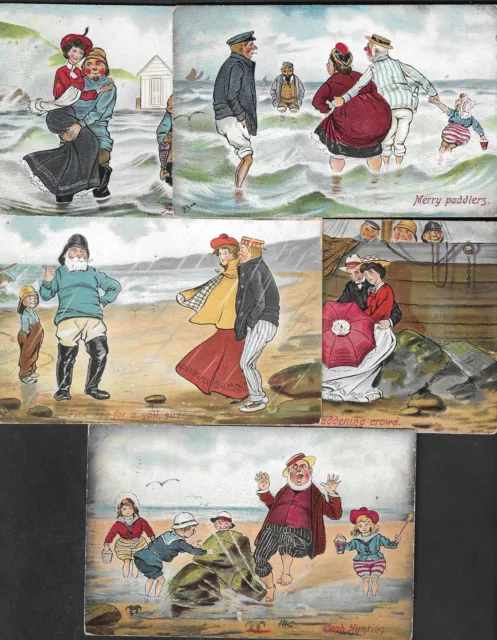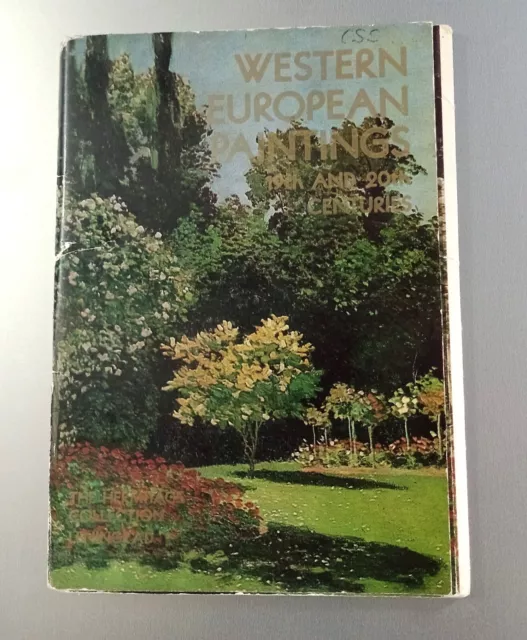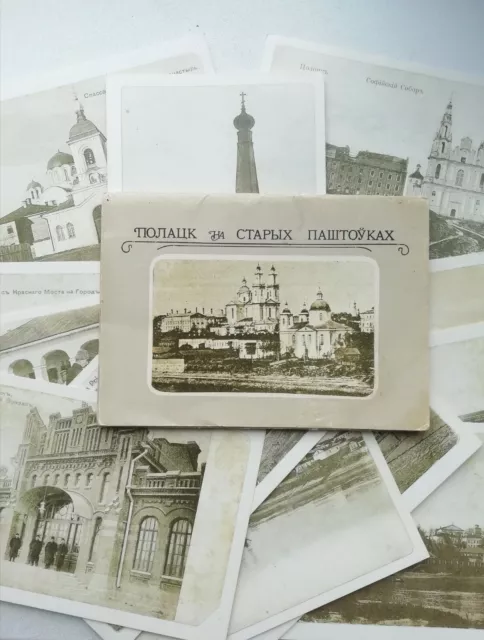Set of postcards "the city of Polotsk on old postcards" 12 pieces 1987
£11.57 Buy It Now or Best Offer, £9.64 Shipping, 60-Day Returns, eBay Money Back Guarantee
Seller: maxseatrade ✉️ (431) 100%,
Location: Polotsk, BY,
Ships to: WORLDWIDE,
Item: 274557230747
Set of postcards "the city of Polotsk on old postcards" 12 pieces 1987. The oldest city in Europe-Polotsk The circulation of sets of postcards is 50,000 copies. Year of release 1987. In Belarusian and Russian language . Publishing house "Belarus" city of Minsk. History of Polotsk "Mother of Belarusian cities", the first capital of Belarus - Polotsk - was built on one of the routes of the great trade route "from the Varangians to the Greeks", at the confluence of the Polota River into the Western Dvina. ..Polotsk is the most ancient city in Belarus, along with Kiev and Novgorod, the most ancient city on the Slavic lands. ..in Polotsk the Belarusian statehood and culture was born, Euphrosinia of Polotsk, Francysk Skorina, Simeon of Polotsk were born there - the glory and pride of the Belarusian people. ..Polotsk was founded by the Krivichs on the site of the settlement of the Baltic tribes at the beginning of the 1st millennium AD. The first settlement of Polotsk arose a kilometer above the confluence of the Polota with the Western Dvina and occupied an area of about 8 hectares. ..The rapid development of the city was facilitated by its convenient geographical position - at the crossroads of the trade route - from the Gulf of Riga through Kiev to the Black Sea and through the upper reaches of the Western Dvina and Volga - to the East . For the first time Polotsk is mentioned in the "Tale of Bygone Years" under the year 862 - with the names Poltesk, Polotsk, Polotsk - "Rurik handed out his castles to Polotsk by his husband." Prince Oleg in 907 "the commandment to give order to Polotsk". ..Polotsk became the center of the Polotsk principality, which was ruled by an independent princely dynasty. One of the most ancient East Slavic principalities existed for more than three centuries. ..The Tale of Bygone Years mentions both the Krivichi and the Polotsk, obviously to distinguish them from the Smolensk and Pskov Krivichi. The first historically famous Polotsk prince was Rogvold. ..Rogvold "held, owned and reigned the Polotsk land", secured the borders of the principality, approved the management system, the political system. The Polotsk principality occupied directly the Polotsk lands, part of the lands of the Dregovichi and Finnish and Lithuanian tribes. ..Polotsk settled along the middle course of the Western Dvina and along the Polota - to the south to the upper reaches of the Svisloch and Berezina. The chronicle says that "Polochans got their name from the river for the sake of, yazhev flows into the Dvina, in the name of Polota" ..the Polotsk principality was located almost along the entire course of the Western Dvina, in the basins of the Berezina and Neman; the principality included the cities of Minsk, Vitebsk, Drutsk, Logoisk, Usvyaty, Borisov, Zaslavl, Lukoml, Orsha. ..The development of the Polotsk principality was facilitated by control over trade routes, which brought in large incomes and conflicts with Kiev and Novgorod, which gradually grew into bloody territorial disputes. ..In 980, Prince Vladimir Svyatoslavich, using the refusal of Rogvold's daughter Rogneda to marry him, "Rabichich", took Polotsk by storm as a pretext for an attack, killed Rogvold and his sons and took Rogneda as his wife. ..in Polotsk, Vladimir left his governor, went to Kiev, killed his brother Yaropolk and became a Kiev prince. ..according to many sources Rogneda gave birth to Vladimir's sons - Izyaslav, later Prince of Polotsk, Yaroslav the Wise, Prince of Novgorod and Kiev, Mstislav, Prince of Chernigov, Vsevolod, Prince Vladimir-Volynsky, and daughters - Predslavalater married the Czech prince Boleslav III the Red, and Premislava, who became the wife of the Ugric king Laszlo the Bald. ..Since 988, the son of Rogneda and Vladimir Izyaslav, who died in 1001, a year after the death of his mother, and left two sons, Vseslav and Bryachislav, became the prince of Polotsk. ..Vseslav died two years later, and in 1003 Bryachislav Izyaslavich, who ruled until 1044, became prince of Polotsk. A long confrontation began between the Polotsk and Kiev princes - for supremacy in the East Slavic lands. ..in 1024 Bryachislav attacked Novgorod and for 5 years ruled it - together with Yaroslav the Wise, through his governors. The case is almost unique in the history of the East Slavic principalities. ..at the same time, a new city of Bryachislavl was built in the principality - modern Braslav, on the lakes - the ancient princes knew well where to arrange their residences. ..The Principality of Polotsk reached its highest prosperity during the reign of Vseslav Bryachislavich the Prophet (1044-1101). ..Until the mid-60s of the 11th century, Vseslav, who well understood that he was facing a life-and-death struggle for the sovereignty of his lands with the Kiev princes, was building and strengthening his state. ..the city was moved from the Polota River to its mouth, to a cape on the right bank of the Western Dvinain the historical study "Polotsk", published in 1987 in Minsk, it is written: "In the second half of the X-XI century, a new fortified city center was formed on a hill with an area of 10 hectares on the right bank of the Western Dvina. ..later this part of the city became known as the Upper Castle. Sophia Cathedral was built on its southern side in the middle of the 11th century. The Upper Castle was a detachment of Polotsk in the 11th-13th centuries and at a later time. ..in the X-XI centuries, the territory was settled near it, as a result of which a vast settlement was formed. It was located in three places: the oldest - near the settlement on the banks of the Polota, Zapolotsky and Veliky Posad (the Lower Castle was then built on its part). ..the area of the Great Posad was 50 hectares. The upper castle was protected from three sides by rivers, and from the fourth - by a moat. " ..Polotsk possessed a significant number of artisans who developed and improved blacksmithing, pottery, leatherworking, shoemaking, cooper's, leatherworking, and jewelry crafts. ..the population was actively engaged in agriculture, horticulture, gardening, cattle breeding, fishing. Trade took place between all the cities of the Eastern European principalities. ..amber was brought from the Baltic, from Kiev - glassware, dishes, from Byzantium - amphorae with wine, from the East - jewelry, fabrics; salt and metals were brought to Polotsk. Polotsk residents exported furs, wax, handicrafts. ..there are few details about the ancient Polotsk - local chronicles have not survived. The Polotsk principality became the main competitor of Kiev. An armed struggle began with varying success. Polotsk fought with Novgorod, Pskov, Smolensk, Kiev. ..until his death in 1101, Vseslav the Prophet fought against the Kiev Yaroslavichs. By the end of the 11th century, the population of Polotsk was about 20,000 people. ..in 1044-1066 in the city was built the Cathedral of St. Sophia by analogy with the Constantinople, possibly in contrast to the Kiev and Novgorod Sophia cathedrals. ..after 1101, the Principality of Polotsk was divided among themselves by the sons of Vseslav the Prophetic into appanages - the principalities of Polotsk, Minsk, Vitebsk, Drutsk, Izyaslavskoe, Logoisk. ..the confrontation between Polotsk and Kiev practically ended in 1127, when the son of Vladimir Monomakh Mstislav with a huge army completely ruined the Polotsk land. Princes David, Rastislav and Svyatoslav with their families were captured and exiled to Byzantium. ..only two returned back. During the second half of the XII century, there was an internecine struggle. By the end of the 12th century, the political significance of the Polotsk land was declining, part of the territories of the former Polotsk principality was captured by Chernigov and Novgorodians. ..in 1201, at the mouth of the Dvina, German missionaries and order knights - crusaders, with the permission of Prince Vladimir of Polotsk, founded the city of Riga. German expansion began on the East Slavic lands. ..The Order of the Swordsmen, which became Livonian in 1237, seized the Livs and Latgalov lands subordinate to Polotsk, the Estonian city of Tartu, the cities of Hertsike and Kukeinos, which were dependent on Polotsk, were taken. ..Vladimir Polotsky fought with the crusaders in 1203, 1206, 1216, but to stop the order, which was constantly replenished by the so-called. "Knights from overpopulated Europe", he was no longer able to. This was the beginning of the end of the independence of the Polotsk land. ..Prince Bryachislav of Polotsk married his daughters to two princes - the great Alexander Nevsky, who constantly defeated the crusaders, and the Lithuanian prince Tovtivill, who became Prince of Polotsk, who ruled until 1263. ..For some time Polotsk was ruled by the people of the Riga archbishop, who were expelled in 1307 by the Polotsk people with the help of the Lithuanian prince Viten. ..in 1307, according to an agreement, Polotsk became part of the Grand Duchy of Lithuania, as its largest city with special rights. ..Polotsk privileges of the beginning of the XIV century (did not survive), the middle and the end of the XIV century, 1430, 1251, the end of the XV century, 1547, 1580, 1593, 1634 guaranteed the indivisibility of the Polotsk lands and the inviolability of the possessions of the nobility and townspeople; governors in Polotskwere appointed by agreement of the Polotsk boyars and townspeople; residents of Polotsk could only be tried by the city court. ..The Brockhaus and Efron Encyclopedic Dictionary wrote at the end of the 19th century: “The son of Mindovg, Voyshelk, put his assistant on the Polotsk table”; then Polotsk and Vitebsk were captured by Voyshelk's enemy, Gerden. ..after Gerden, news about the Polotsk land became very scarce; it is even difficult to establish who ruled here. ..in the second half of the 13th century, some, perhaps, a Lithuanian prince, who seized Polotsk, converted to Catholicism and bequeathed Polotsk to the Germans, who began to plant Catholicism here. ..Polotsk turned to the Lithuanian prince Viten, and he, in 1307, took possession of the Polotsk land. Then the brother of Viten and Gediminas the Warrior was reigned here as an assistant to the Grand Duke of Lithuania. ..in 1342 the Warrior died; after him reigned Gleb-Narimunt Gediminovich and Andrei Olgerdovich, who was dependent on his father. ..when Yagailo became the Grand Duke of Lithuania, Andrei declared his rights to the great reign and entered into a struggle with Jagail, but could not resist in Polotsk and went to Pskov, and then to the Moscow prince. ..Polotsk obeyed Yagailo, who gave it to his brother, Skirgai-lo. The Polotsk people soon drove away Skirgailo; Keistut returned Polotsk to Andrei, and Vitebsk was given to the deprived of the great reign of Yagailo. ..when Jagiello again took the grand-princely throne, Andrew surrendered to the protection of the Livonian Order and tried to seize the Grand Duke. The attempt was unsuccessful: Skirgailo took Polotsk, Andrei was exiled to Poland. ..the Polotsk people were indignant against Skirgailo, but were pacified. In 1392, Polotsk surrendered to Vitovt, who, apparently, ruled it through governors. " ..in the XIV century the crusaders besieged Polotsk several times - twice in 1324, in 1333, 1334, 1366, 1382 and 1386, but they could not take the city. MTkachev wrote in his work “Castles of Belarus” in 1987: “By the 60s of the 15th century, Polotsk had reached the largest territorial size in its entire history. Moreover, both Zapolotsky and Bolshoi Posad had their own line of fortifications. ..Polotsk proudly wrote about their hometown: "The place of Polotsk is a glorious place, like which, and it does not eat in honor of Gdansk, neither Krolevets, nor Marienbrok." There are no descriptions of the fortifications of Polotsk of the XIV-XV centuries. ..how many towers there were on the Upper Castle is unknown. " In 1498 Polotsk received the Magdeburg Law and soon became the richest city after Vilna in the Grand Duchy of Lithuania. A magistrate was established in the city. ..however, the city was ruled by a voit appointed by the grand duke. The current administration of Polotsk was led by the Rada - a council of 20 people headed by two burgomasters - an Orthodox and a Catholic. ..Polotsk had extensive trade ties - with Riga, Novgorod, Pskov, Moscow, and the West. However, the Livonian Order did not allow the Polotsk merchants to enter the Baltic, and they traded through German intermediaries, which caused constant trade conflicts. ..from the old letters of 1265 and 1405, which have survived, only memories remain.in 1504 the Polotsk voivodeship was formed with the center in Polotsk, without povetas with cities and towns - Beshenkovichi, Vetrino, Glubokoe, Disna, Drissa, Kublichi, Lepel, Lukoml, Sebezh, Osveya, Ulla, Chashniki. ..by this time, great work had been carried out to strengthen the Polotsk castle and the city's posadov, surrounded by ramparts and moats. In the first half of the 16th century, Polotsk was besieged by the Tatars several times - in 1506, 1508. ..Tatars plundered and burned the surroundings, they did not take the castle and left. In 1512, 1513, 1518, 1519, 1520, 1534, 1535 Polotsk was besieged by the Moscow troops of the Grand Duke Vasily Ivanovich, but the city was not taken. Again they burned down the surroundings and drove away the prisoners. ..after many sieges, Polotsk was restored, rebuilt fortifications, the city became a first-class fortress of that time. ..castle fortifications consisted of 9 towers up to 7 meters in height, large in size, connected by log walls "with several logs" (6 meters), ditches and ramparts. Dozens of cannons stood in the tower loopholes. The walls were 4 kilometers long. ..in the city with settlements lived about 40,000 inhabitants. Polotsk was first taken during the Livonian War of 1558-1583. In January 1563, a huge army of Tsar Ivan the Terrible with 150 guns laid siege to Polotsk. Artillery shelling and assaults began. ..the 40-thousandth army of the Great Hetman of Lithuania Nikolai Radziwill came to the aid of Polotsk, but he did not manage to break through to the city. From February 9 to February 14, artillery shelling began around the clock, the cannonballs of battering guns weighed up to 300 kilograms. ..on the night of February 15, the archers crept up to the castle walls and lit them, as a result of which a large gap was formed, in which a bloody battle began in the morning. On February 15, 1563, Voivode Dovoyna surrendered Polotsk under the promise of life, freedom, etcsafety of property.The city was restored and for 16 years was under the rule of the Muscovy. In August 1579, after a 20-day siege and desperate resistance from the Moscow garrison, Polotsk was taken by the troops of the Polish king Stefan Batory. ..the castle and the city were rebuilt. In 1580, Stephen Batory invited the Jesuits to Polotsk, led by P. Skarga, who a year later built the Jesuit collegium, the magnificent St. Stephen's Cathedral. ..the Jesuits opened a publishing house and a printing house, a pharmacy, a theater at the cathedral, and laid a botanical garden. Polotsk itself consisted of the Upper and Lower castles, had 6 posadov, 80 streets and lanes. ..at the beginning of the 17th century, there was a strong fire in Polotsk, which was repeated in 1615. The city fortifications were not restored for a long time. On a June night in 1633, Polotsk was attacked by the Moscow army of governors A. Repnin and N. Plescheev. ..they besieged Polotsk, but were repulsed by the royal troops who came to the aid of the city.the summer fire of 1643 burned down "the whole place of Polotsk, the castle Vyshniy and Nizhniy, the Collegium, churches, churches, town halls, vezha and parkan and all the chills of the Polotsk place burned down and turned to ashes." ..by 1654 they tried to restore the castle — the Russian-Polish war of 1654-1667 was approaching — but little was done. In the summer of 1654, the 50-thousandth army of the governor V.P. Sheremeteva went to Polotsk. ..the siege continued throughout the end of June. On June 30, the conditions for the surrender of the city were agreed and Moscow troops entered Polotsk, restored the Upper and Lower castles and installed 4 new towers, cannons, squeaks, and earthen bastions. ..in June 1662, as a result of a fire, almost the entire Lower Castle burned down. In 1667, according to the Andrusov treaty, Polotsk was returned to the Poles. Only wooden fortifications remained in the castle, bastions were built. Polotsk was again ravaged during the Great Northern War in 1704. ..in the summer of 1705, Peter I lived in Polotsk for a month. The city completely fell into decay. After the first two partitions of the Polish-Lithuanian Commonwealth, Polotsk became part of the Russian Empire, as the center of the Polotsk province, governorship, since 1796 - the district center. ..in the 1770s, there were 360 houses and about 2000 residents in Polotsk, after 10 years - 800 houses and 5000 residents. In 1811 - 900 houses and 7000 inhabitants. Polotsk became the most important transit city connecting the center of Russia through Riga with Western Europe. ..During the Patriotic War of 1812, after a 4-month occupation by the French and two fierce battles, Polotsk was completely destroyed, with about 3,000 inhabitants remaining in the city. In August 1812, the Russian corps of P.Kh. ..Wittgenstein, covering Petersburg, attacked the French corps of S. Oudinot and G. Saint-Cyr near Polotsk. As a result of three days of fighting, the French fortified themselves in Polotsk, the Russians - at Drissa. ..everyone remained in this position until October, until the retreat and flight of Napoleon. Fierce battles on October 18-20, 1812 led to the fact that the French were driven out of Polotsk, completely destroyed; both sides lost 7000 soldiers killed. ..the bridge over the river Polota, covered in blood, became known as Red. It was possible to partially restore Polotsk by 1820. Trade and crafts were revived in the city. ..in the first half of the 19th century, rapid urban growth began in Belarus; the population of Polotsk reached 15,000 inhabitants. The city often suffered from fires - in 1837 300 houses burned down, in 1848 - the city center, in 1862 - 1600 houses. ..by the end of the 19th century, more than 20,000 inhabitants lived in Polotsk. A cadet corps, a teacher's seminary with a preparatory class and an elementary school, several male and female schools, a hospital, pharmacies, and printing houses operated. ..there were fifteen hundred houses in the city, of which 126 were stone. There were about 300 craft workshops with a thousand workers. By 1910 Polotsk consisted of 5 parts: the Upper and Lower Castle, the central part, the southern part - Zadvinye, the western part - Zapolotye. The city began to develop after the construction of the Riga-Oryol railway in 1866, which passed through Polotsk. ..in November 1917, Soviet power was established in Polotsk; from February to November 1918 - occupied by Germany; from September 1919 to May 1920 the left bank of Polotsk was occupied by Poland. ..in 1919-1924 Polotsk - part of the RSFSR; since 1924 - in the Byelorussian SSR, regional center. In 1939, 30,000 inhabitants lived in Polotsk. During the fascist occupation in Polotsk, about 150,000 people were killed by the Nazis. ..in 1944-1954 Polotsk was the center of the Polotsk region, which included 15 districts - Vetrinsky, Drissensky, Osveysky, Polotsky, Rossonsky, Ushachsky, Braslavsky, Vidzsky, Gluboksky, Disnensky, Dokshitsky, Dunilovichsky, Miorsky, Plissky, Sharkovshchinsky .after the abolition of the Polotsk region, Polotsk is the regional center of the Vitebsk region. At the beginning of the XXI century, more than 80 thousand inhabitants live in Polotsk. ..Polotsk is the cultural center of Belarus, which houses the National Polotsk Historical and Cultural Museum-Reserve, the Museum of Local Lore, the Museum of Belarusian Printing, the Museum of Simeon of Polotsk, the Museum of the History of Architecture of the St. Sophia Cathedral ;monuments to Euphrosyne of Polotsk, Francis Skaryna, Simeon of Polotsk were erected.Many monuments of history and culture have been preserved in Polotsk. The famous St. Sophia Cathedral was built in 1044-1066 by Byzantine architects and Polotsk builders. ..the cathedral kept the Polotsk Chronicle and the library, which disappeared during the Livonian War. During the Northern War, a powder store was placed in the cathedral - by order of Peter I. In 1710, gunpowder exploded and the temple was significantly damaged. The cathedral was rebuilt in the 1738-1750s in the late Baroque style by the architect I. Glaubits. ..part of the foundation, apse, crypt remained from the cathedral of the XI century. Saint Sophia Cathedral was restored in 1985. The concert organ hall hosts performances by world celebrities . Spaso-Euphrosyne monastery was founded in 1128 by the Monk Euphrosyne of Polotsk. The Church of the Savior Euphrosyne was built by order of Euphrosyne in 1161. ..it has preserved unique frescoes of the 12th century, one of which, perhaps, is the image of the Venerable Euphrosyne herself. In 1893-1897, the Cathedral of the Exaltation of the Cross was built in the monastery in the Russian-Byzantine style https://ru.m.wikipedia.org/wiki/%D0%9F%D0%BE%D0% BB%D0%BE%D1%86%D0%BA 100% ORIGINAL! Good condition (see photo) nice and rare item for your collection Ask me any questions. Payment: Paypal USA, European Union - Delivery time is about 14-20 days, by airmail with track number Other countries - Delivery time about 21-30 days. If you have any problems with the delivery or the goods, please let me know so that we can discuss and solve the problem together. Please check my other items in my store.
- Condition: Used
- Condition: Good condition See photo
- Features: Panoramic
- Modified Item: No
- Subject: Belarus
- Era: Post-War (1945-Now)
- Region: Polotsk
- Country/Region of Manufacture: Belarus
- Year Manufactured: 1987
- Postage Condition: Unposted
- Original/Licensed Reprint: Original
- Unit of Sale: Set
- Theme: Art
- Type: Printed (Lithograph)
PicClick Insights - Set of postcards "the city of Polotsk on old postcards" 12 pieces 1987 PicClick Exclusive
- Popularity - 0 watchers, 0.0 new watchers per day, 1,262 days for sale on eBay. 0 sold, 1 available.
- Best Price -
- Seller - 431+ items sold. 0% negative feedback. Great seller with very good positive feedback and over 50 ratings.
People Also Loved PicClick Exclusive

5 x BOB ARTIST SIGNED OLD POSTCARDS COMIC ON THE SEASHORE PART SET MISCH & CO
£8.99 0 Bids 1d 3h
Set of 25 Different Art Postcards NEW Old Vintage Stock, great for postcrossing
£7.39 Buy It Now 3h 43m
set of 4 old postcards JUDAICA Caricature of the circumcision by Herzig & others
£16.38 Buy It Now 16d 7h
Vintage Set Of 16 Postcards, Selected Western European Paintings, 1987
£5.00 Buy It Now 27d 10h
1987 Soviet Ful Set 21 postcards The Steadfast Tin Soldier USSR Russian
£21.20 Buy It Now 13d 11h


